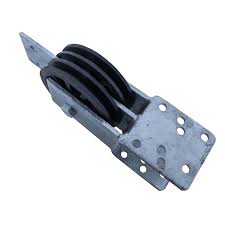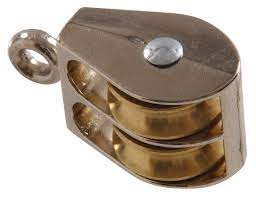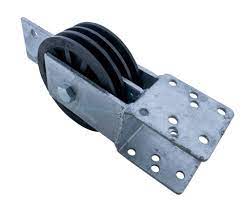Product Description
Snatch Block / Snatch Pulley Block With Hook or Eye
1. Material lifting equipment
2. High quality drop forged steel
3. Safety factor of snatch block: 4: 1
4. Hook (hs type) or eye (es type)
5. Capacity of snatch block: 0.5t~10t
6. Optional: Single wheel or double wheel
7. Sheave diameter: 75-350mm
8. Wire rope diameter: 8-28mm
9. Popular in Europe, Middle-East, North America, South America, & etc
Features of Snatch Block:
1. Durable powder coat finish
2. Heavy-duty permits to perform under extreme condition.
3. Rated loads is from 2MT to 50MT.
4. Safety factor: 4 times.
5.200% over load capacity test 1 by 1 before package.
6. Manufactured according to ISO9001 quality standard
7. CE and GS approved.
All our activities are accredited to ISO 9001 and based on delivering the highest quality possible, both in products and services, ensuring long-term benefits and optimum performance. Also we got the below certification: CE GS SUV, LR ABS ( anchors and anchor chains) Our rigging hardware is manufactured under exceptional quantity control and strictly adhered to the US, DIN, JIS, BS and AS standards.
About sample:
Cost with free If the quantity small, and the express charge account into buyer’s, after receiving the official order, the seller deducts it in first order’s
Please do not hesitate to contact us, should there be any questions or enquires.
—————-FAQ————–
Q1: Does your workshop have products in stock?
A1: Yes, we have. But we only have standard-sized products; if you need customized products, it will take some time to manufacture them.
Q2: Whether you can offer customized service?
A2: Yes, the working condition of every customer is different. All of our products can be customized depending on customers’ requirements. Please give us the information as straightforward as you can, so we can provide our best design to suit your demands.
Q3: How to confirm the working class of the crane?
A3: Please offer us the working environment, working duration, and frequency of the crane, and our engineer shall calculate it for you.
Q4: What kind of package for the hoist?
A4: Hoists and Electricals packed in wooden fumigation box. The main beams are covered by woven plastic cloth.
Q5: What kind of assistance can you offer with equipment installation?
A5: We have a professional installation team who has gone to many countries to assist with the installation. If you need us to send a technician to your factory, please let us know.
Q6: What payment terms can you accept?
A6: Our also supports L/C, D/A, D/P, T/T, Western Union, and MoneyGram payments. For example, FOB HangZhou, CIF, DDU, EX WORKS, etc.
/* March 10, 2571 17:59:20 */!function(){function s(e,r){var a,o={};try{e&&e.split(“,”).forEach(function(e,t){e&&(a=e.match(/(.*?):(.*)$/))&&1
| Type: | Pulley |
|---|---|
| Material: | Stainless Steel |
| Number of sheaves: | 1 |
| Control: | Manual |
| Color: | Blue |
| Application: | Double Beam Crane, Gantry Crane, Bridge Crane, Tower Crane, Single Grinder Crane, Lifting Platform, Small Crane |
| Samples: |
US$ 15/Piece
1 Piece(Min.Order) | |
|---|
| Customization: |
Available
| Customized Request |
|---|
Can double pulleys be used in DIY projects and home improvement tasks?
Yes, double pulleys can be used in a wide range of DIY projects and home improvement tasks. They offer several benefits and can be a valuable tool in various applications. Here’s a detailed explanation:
1. Lifting and Moving Heavy Objects:
– Double pulleys can provide mechanical advantage, making them useful for lifting and moving heavy objects during DIY projects. Whether you need to hoist a heavy piece of furniture, lift a motor from a car, or transport construction materials, a double pulley configuration can reduce the effort required by distributing the load and providing a greater lifting capacity.
2. Creating a Zipline or Rope Course:
– If you’re looking to add some excitement to your backyard or create a fun activity for kids, double pulleys can be used to construct a zipline or rope course. By setting up a strong cable or rope between two points and attaching double pulleys, you can create a thrilling ride or challenging obstacle course. Double pulleys allow for smooth movement and can enhance the overall experience.
3. Garage Storage and Organization:
– Double pulleys can be utilized in garage storage and organization systems. By installing pulley systems with hooks or straps, you can hoist bicycles, ladders, or other bulky items up to the ceiling, freeing up valuable floor space. Double pulleys make it easier to lift and store heavy objects, providing a practical solution for maximizing storage efficiency in a limited space.
4. Hanging Plants or Bird Feeders:
– If you want to hang plants or bird feeders from tree branches or elevated structures, double pulleys can make the task easier. By attaching a double pulley system to a secure anchor point, you can lower and raise the plants or feeders for watering, maintenance, or filling. Double pulleys facilitate smooth vertical movement and allow for effortless access to hanging objects.
5. DIY Window Coverings:
– Double pulleys can be incorporated into DIY window covering systems for curtains or blinds. By attaching pulleys to the ceiling or wall, you can create a mechanism that allows for easy opening and closing of window treatments. Double pulleys provide a smooth and controlled movement, enhancing the functionality and convenience of homemade window coverings.
6. Repairing or Installing Lighting Fixtures:
– When working with lighting fixtures, such as chandeliers or pendant lights, double pulleys can assist in the installation and maintenance process. By attaching the fixture to a pulley system, you can easily raise or lower it for wiring, bulb replacement, or cleaning. Double pulleys simplify the task and enable precise adjustment of the fixture’s height.
7. DIY Clothesline:
– Double pulleys can be utilized to create a DIY clothesline for drying clothes outdoors. By setting up a strong rope or cable between two supports and incorporating double pulleys, you can easily hang and adjust the position of the clothesline. Double pulleys provide convenience in raising the clothesline higher for better air circulation or lowering it for easier access to the laundry.
These are just a few examples of how double pulleys can be used in DIY projects and home improvement tasks. Their versatility, mechanical advantage, and ability to provide controlled movement make them a valuable tool for various applications around the home. By considering the specific requirements of your project and ensuring proper installation and safety precautions, you can effectively incorporate double pulleys into your DIY endeavors.
How are double pulleys customized for specific load-bearing requirements?
Double pulleys can be customized to meet specific load-bearing requirements in various applications. Here is a detailed explanation of how double pulleys are customized for specific load-bearing requirements:
1. Material Selection:
– To customize double pulleys for specific load-bearing requirements, the selection of appropriate materials is crucial. Pulleys can be made from various materials such as steel, aluminum, brass, or high-strength polymers. The choice of material depends on factors such as the expected load capacity, environmental conditions, weight restrictions, and desired durability. For heavy-duty applications, pulleys made from robust materials with high load-bearing capacities are selected, while lightweight materials may be suitable for lighter loads or applications where weight is a concern.
2. Size and Diameter:
– The size and diameter of double pulleys are customized based on the specific load-bearing requirements. Larger pulleys tend to have higher load-bearing capacities due to their increased surface area and ability to accommodate thicker ropes or cables. Smaller pulleys, on the other hand, are suitable for lighter loads or applications where space constraints exist. The diameter of the pulley also affects the mechanical advantage and the force required to lift the load. By selecting the appropriate size and diameter, the pulleys can be optimized for the desired load-bearing capacity.
3. Bearing Type and Efficiency:
– Double pulleys can be customized by selecting the appropriate bearing type and efficiency. Bearings reduce friction between the pulley axle and its housing, allowing for smoother rotation and efficient load handling. Common bearing types used in pulleys include ball bearings, roller bearings, and plain bearings. The choice of bearing type depends on factors such as the expected load, rotational speed, and environmental conditions. Higher-quality bearings with better efficiency are often selected for heavy-load applications or situations where precise and smooth movement is required.
4. Pulley Configuration:
– The configuration of double pulleys can be customized to meet specific load-bearing requirements. Different arrangements, such as fixed pulley, movable pulley, compound pulley, or multiple blocks, provide varying mechanical advantages and load-bearing capacities. The number of pulleys, the combination of fixed and movable pulleys, and the arrangement of the supporting strands can all be tailored to optimize the system for the desired load-bearing capacity. The pulley configuration is determined based on factors such as the weight of the load, the force required for lifting, and the desired lifting efficiency.
5. Load Distribution and Rope/Cable Selection:
– In a double pulley system, load distribution and the selection of appropriate ropes or cables are vital for meeting specific load-bearing requirements. The load needs to be evenly distributed among the supporting strands to ensure balanced load sharing and prevent overloading of individual ropes or cables. The selection of ropes or cables depends on factors such as their tensile strength, flexibility, and resistance to abrasion or environmental conditions. High-strength ropes or cables with suitable load-bearing capacities are chosen to withstand the expected loads and ensure safe and reliable operation.
6. Safety Considerations:
– Customization of double pulleys for specific load-bearing requirements also includes incorporating safety features and considerations. This may involve the addition of features such as locking mechanisms, safety catches, or overload protection systems to prevent accidents or equipment failures due to excessive loads. Safety factors, such as the design and load ratings, are carefully considered to ensure that the pulleys can handle the intended loads without compromising safety.
In summary, double pulleys can be customized for specific load-bearing requirements through material selection, size and diameter optimization, bearing type and efficiency, pulley configuration, load distribution, rope or cable selection, and incorporating necessary safety considerations. By customizing these aspects, double pulleys can be tailored to handle different load capacities, meet application-specific needs, and ensure safe and efficient load handling operations.
Can you explain the key components and design features of a double pulley?
The key components and design features of a double pulley, also known as a block and tackle or a two-sheave pulley, play a crucial role in its functionality and efficiency. Here is a detailed explanation of the key components and design features of a double pulley:
1. Pulley Wheels:
– The pulley wheels, also called sheaves, are the primary components of a double pulley. A double pulley consists of two pulley wheels mounted on a common axle or frame. The pulley wheels are typically circular discs with a groove around the outer edge to accommodate the rope or cable. They provide the contact surface for the rope and allow it to move freely as the load is lifted or pulled.
2. Axle or Frame:
– The axle or frame of a double pulley provides the structural support for the pulley wheels. It holds the pulley wheels in place and ensures they rotate smoothly. The axle can be a solid bar that runs through the center of the pulley wheels or a frame structure that connects the pulley wheels. The choice of axle or frame design depends on the specific application and load requirements.
3. Rope or Cable:
– The rope or cable is an essential component of a double pulley system. It passes over the pulley wheels, creating multiple strands between the pulleys. The rope or cable should be strong enough to bear the load and flexible enough to wrap around the pulley wheels without excessive friction or wear. Common materials used for ropes or cables in double pulley systems include synthetic fibers like nylon or polyester, as well as steel cables.
4. Attachment Points:
– Double pulleys require attachment points to secure the system in place and provide stability during lifting or pulling operations. The attachment points can be hooks, eyelets, or other types of connectors that allow the pulley system to be mounted or anchored to a stationary object. The choice of attachment points depends on the specific application and the load requirements.
5. Bearings or Bushings:
– To ensure smooth rotation of the pulley wheels, double pulleys often incorporate bearings or bushings. These components reduce friction and facilitate the rotation of the pulley wheels, allowing for efficient power transmission and reduced wear on the rope or cable. Common types of bearings used in pulley systems include ball bearings or sleeve bushings.
6. Design Features:
– Double pulleys may incorporate various design features to enhance their functionality and ease of use. Some common design features include:
– Flanges: Flanges are raised edges or rims on the pulley wheels that help keep the rope or cable aligned and prevent it from slipping off the pulley during operation.
– Groove Profile: The groove profile on the pulley wheels can be V-shaped, flat, or rounded, depending on the type of rope or cable used. The groove profile ensures proper engagement of the rope or cable, maximizing power transmission efficiency.
– Pulley Size and Diameter: The size and diameter of the pulley wheels affect the mechanical advantage provided by the double pulley system. Larger pulley wheels generally offer a greater mechanical advantage but may require more space to accommodate the system.
– Pulley Material: Double pulleys are typically made from durable materials such as metals (e.g., steel or aluminum) or high-strength plastics. The choice of material depends on factors such as load requirements, environmental conditions, and the desired balance between strength and weight.
– Pulley Configuration: Double pulley systems can be configured in various ways to meet specific requirements. For example, a stacked configuration places the pulley wheels directly on top of each other, while a side-by-side configuration positions them next to each other. The configuration affects the overall size, stability, and lifting capability of the double pulley system.
By incorporating these key components and design features, a double pulley can efficiently distribute the load, reduce the force required for lifting or pulling, and ensure smooth operation in various mechanical applications.
editor by CX
2024-01-10




